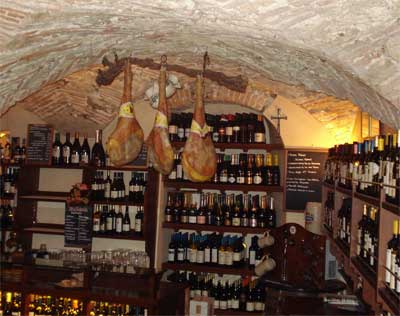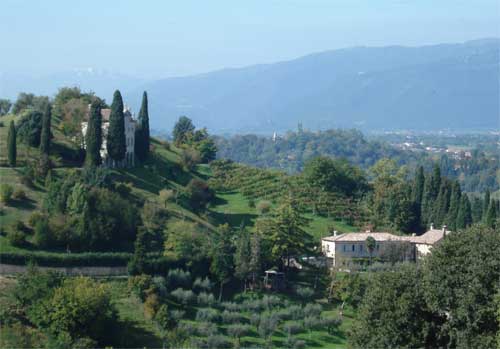The Good Wines (and Food!) of Northeast Italy
© by Neil Duarte
Most new aficionados of Italian wine are familiar with the offerings of Tuscany and Piedmont but only a few know the lesser-known yet excellent wines produced in Friuli and the Veneto.
 | |
| An enoteca (wine shop) in San Danielle featuring local wines and the outstanding prosciutto. Photo: Terry Duarte |
Though Friuli produces a number of excellent white wines and is judged by some to have the best Pinot Grigios in Italy, I believe that its best offering is called Friulano. Long known as Tocai Friulano, it recently lost the "Tocai" moniker under European Union orders, to avoid confusion with the sweet Tokaji wines produced in Hungary, Friulano is a clean, crisp dry white that generally has a hint of spice and fruit taste. The fruit taste will very slightly between producers, but the wine leaves a clean taste. Some experts such as Joseph Bastianich, whose family came from this area, consider it a distant relative of Sauvignon Blanc. Friulano is a wine worth remembering and tasting whenever you find it (and more is being exported to the US). Two of the leading producers are Le Vigne di Zamo (www.levignedizamo.com) and Mario Schiopetto (www.schiopetto.it). Friulano is advertised as the perfect wine to serve with prosciutto and I can vouch for that from personal experience.
Prosciutto di San Danielle (produced in a town of the same name in the western part of Friuli and well worth a visit) is one of the most famous prosciuttos in Italy. However, if you are around Cormons you should try the local Prosciutto di Cormons along with a bottle of Friulano. The Prosciutto di Cormons is drier and usually served in a bit thicker cut, but very tasty. An excellent restaurant at which to try this is La Subida (tel 39 0481 60531) located just outside Cormons. It is one of the best restaurants I have visited anywhere. The restaurant and its owners are warm and very hospitable, the ambiance is elegant but not pretentious and the food is fantastic. It also has a great local wine list.
 | |
| A typical hillside vineyard in the Veneto with the Dolomite Mountains in the background. Photo: Terry Duarte |
For those who like a sparkling wine, Prosecco is an excellent choice either as an aperitif or even as a cocktail. Last year my wife and I stayed in the Conegliano area north of Treviso at the wine producing Agriturismo Demetra (www.agriturismo.com/demetra) where Prosecco is produced along with two organic red wines. Though I generally do not like sparkling wines, I was pleasantly surprised by their Prosecco. Maurizio and Bianca Bonotto, owners of the agriturismo, operate a small but first class winery without a fancy tasting room. In addition to their signature Prosecco, they produce an organic Cabernet, a blend of Cabernet Sauvignon and Cabernet Franc as well as an organic Merlot. All are sold under the Demetra label. Both of these red wines were very smooth and clean with no harsh aftertaste. My initial impression of organic wines, based purely on their offering, is most positive.
In the future if you plan to visit the most popular tourist destination in the area, Venice, try to add enough time to your schedule to visit the other parts of the Veneto or Friuli. You will not regret the effort.
July 2009
